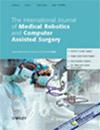i-MYO: A multi-grasp prosthetic hand control system based on gaze movements, augmented reality, and myoelectric signals
Abstract
Background
Controlling a multi-grasp prosthetic hand still remains a challenge. This study explores the influence of merging gaze movements and augmented reality in bionics on improving prosthetic hand control.
Methods
A control system based on gaze movements, augmented reality, and myoelectric signals (i-MYO) was proposed. In the i-MYO, the GazeButton was introduced into the controller to detect the grasp-type intention from the eye-tracking signals, and the proportional velocity scheme based on the i-MYO was used to control hand movement.
Results
The able-bodied subjects with no prior training successfully transferred objects in 91.6% of the cases and switched the optimal grasp types in 97.5%. The patient could successfully trigger the EMG to control the hand holding the objects in 98.7% of trials in around 3.2 s and spend around 1.3 s switching the optimal grasp types in 99.2% of trials.
Conclusions
Merging gaze movements and augmented reality in bionics can widen the control bandwidth of prosthetic hand. With the help of i-MYO, the subjects can control a prosthetic hand using six grasp types if they can manipulate two muscle signals and gaze movement.

 求助内容:
求助内容: 应助结果提醒方式:
应助结果提醒方式:


